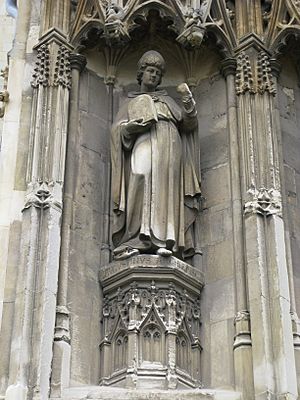List of members of the Gregorian mission facts for kids
The Gregorian mission was a special group of Christian monks and priests. They were sent by Pope Gregory the Great from Italy to Britain. Their goal was to teach the Anglo-Saxons about Christianity. This happened in the late 500s and early 600s. The Anglo-Saxons at that time followed their own old beliefs, called Anglo-Saxon paganism.
Contents
The Journey to Britain
The first group of missionaries had about 40 monks and priests. Some of them had been monks in Pope Gregory's own monastery in Rome. Their journey was long and hard. They almost gave up and went back to Rome! But they kept going.
Arriving in Kent
In the year 597, they finally arrived in the kingdom of Kent. This was an Anglo-Saxon kingdom in Britain. A few years later, in 601, Pope Gregory sent a second group. These new missionaries brought more help. They also brought books and relics for the new churches. Relics are special items linked to saints or holy events.
Spreading the Word
From Kent, the missionaries tried to spread Christianity. They went to the East Anglian kingdom. They also went to the north of Britain. However, after King Æthelberht of Kent died, the mission mostly stayed in Kent.
Around 625, another mission went to the kingdom of Northumbria. This happened when King Æthelberht's daughter married King Edwin of Northumbria. But after King Edwin died in 633, many people went back to their old beliefs. Most missionaries had to leave Northumbria. They were afraid of the pagans who were now in power.
Learning About the Mission
Most of what we know about these missionaries comes from a book. It's called Historia ecclesiastica gentis Anglorum. A medieval writer named Bede wrote it around the year 731. Bede wrote down many details about the mission members.
Another important source is the Pope's old records. These records include copies of letters Pope Gregory sent to the missionaries. Neither of these sources lists every single missionary. So, we have to find information about them from different parts of Bede's book and Gregory's letters. We know about 40 people were in the first group. But we don't know how many were in the second group. Because of this, we only know the names of some of the missionaries.
Important Missionaries
Many of the known missionaries became important church leaders. They became bishops or archbishops. Most of the others became abbots. An abbot is the head of a monastery.
Archbishops and Bishops
One person, James the Deacon, never became a higher church leader than a deacon. A deacon is a church assistant. The first five Archbishops of Canterbury were all from this mission. They were Augustine, Laurence, Mellitus, Justus, and Honorius. All of them were later made saints. This means they were officially recognized as holy people.
Two other missionaries also became bishops. They were Paulinus and Romanus.
Abbots and Saints
Other missionaries became abbots of the monastery that Augustine started in Canterbury. This monastery is now known as St Augustine's Abbey. The abbots included Gratiosus, John, Peter, Petronius, and Rufinianus. Besides the five archbishops, three other missionaries are also considered saints. They are Peter, James the Deacon, and Paulinus.
Members of the Mission
The table below lists some of the known members of the Gregorian mission. The "Date of arrival" column shows if they came with the first group in 597 or the second group in 601. For some, we don't know the exact date. The "Major ecclesiastical offices" column tells you the most important church jobs they held. The "Death date" column shows when they died, or an approximate date if it's not known. The last column tells you if they were made a saint.
| Name | Date of arrival in England |
Major ecclesiastical offices | Death date | Canonized |
|---|---|---|---|---|
| Augustine of Canterbury | 597 | first Archbishop of Canterbury (597–604) | Between 604 and 609 | Yes |
| Gratiosus | Unknown | fourth Abbot of St Augustine's, Canterbury (626–638) | 638 | No |
| Honorius of Canterbury | Either 597 or 601 | fifth Archbishop of Canterbury (627–653) | 653 | Yes |
| James the Deacon | Unknown | Deacon | After 671 | Yes |
| John | Either 597 or 601 | second Abbot of St Augustine's, Canterbury (607–618) | Unknown | No |
| Justus | 601 | first Bishop of Rochester (604–624) fifth Archbishop of Canterbury (624–627?) |
627 | Yes |
| Laurence of Canterbury | 597 | second Archbishop of Canterbury (604–619) | 619 | Yes |
| Mellitus | 601 | first Bishop of London (604–617) third Archbishop of Canterbury (619–624) |
624 | Yes |
| Paulinus of York | 601 | first Bishop of York (625–633) third Bishop of Rochester (633–644) |
644 | Yes |
| Peter of Canterbury | 597 | first Abbot of St Augustine's, Canterbury (598–605) | circa 607 or after 614 | Yes |
| Petronius | Unknown | fifth Abbot of St Augustine's, Canterbury (640–654) | circa 654 | No |
| Romanus | Either 597 or 601 | second Bishop of Rochester (624) | circa 624 | No |
| Rufinianus | 601 | third Abbot of St Augustine's, Canterbury (618–626) | Before 638 | No |


